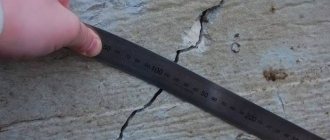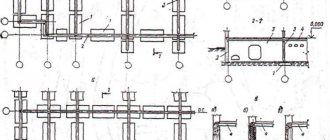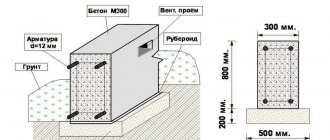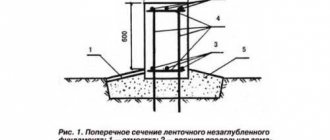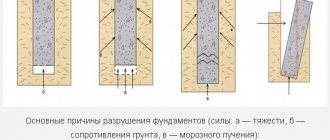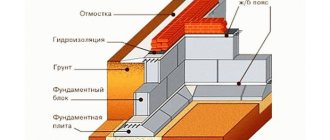The choice of foundation type depends on several factors: soil type, material, size of the planned house and the financial condition of the future owner. In some cases, the initial stage and further process can be reduced in cost by using wood concrete. This material has a number of advantages, since it is lightweight, affordable, due to the low cost of the material, and has excellent thermal insulation properties.
Advantages and disadvantages of wood concrete
In modern construction, the use of wood concrete is a way to save on the cost of materials and installation without compromising the quality of the structure. The composition of wood concrete blocks and panels includes several main components: cement (or clay), wood chips. When sand is added to the mixture, a type of material called sawdust concrete is obtained.
Arbolite is widely used in construction due to the following properties:
- does not disturb the air exchange in the room, retaining heat;
- the ideal combination of high strength and relatively low weight;
- you can erect a building of up to 3 floors with a wall thickness of 30 cm and reinforced concrete floors;
- resistant to infection by fungi, bacteria and rot;
- easy to process with tools and holds fasteners;
- not susceptible to open flames and high temperatures (according to test results, it did not ignite under open fire and temperatures up to 1000 degrees for 90 minutes);
- has good sound insulation properties.
The only disadvantage of wood concrete is considered to be low resistance to moisture, so it is extremely rarely used as a foundation material.
You can find out a specialist’s opinion about wood concrete, its properties and application by watching the following video:
Which foundation is preferable for wood concrete houses?
In the case of the construction of buildings with a small mass of wall structures underneath, from a financial point of view, it is advisable to use pile or strip foundations.
Pile foundation
A foundation with such design features is relevant when building in areas with low soil density or an uneven ground surface (complex terrain, quicksand, or significant differences in height).
Piles are special rods made of reinforced concrete or steel, which are buried into the soil to the depth of its layers with sufficient strength to ensure the required level of bearing capacity.
The type of piles used has a significant influence on the characteristics of the foundation for a wood concrete house. There are bored and screw rods.
Bored piles
Such piles are monolithic reinforced concrete structures that are erected within the construction site. To install them, you need to make special holes in the ground of the required diameter and at the distance specified in the design documentation. Next, special reinforcement structures are installed in the niches, after which the final stage of pile manufacturing is performed - pouring concrete of a certain grade, followed by compaction. It is necessary to calculate the distance of each element of the base for specific construction conditions, but generally, when constructing houses from wood concrete, the step is 2.5-3 meters.
Screw piles
Such rods look like pipes with blades, the ends of which are pointed.
Such features allow the supports to be screwed into the ground. The presence of blades further increases the load-bearing capacity. For installation, a head is used, which will also become the support of the new structure. If you make a choice between types of piles, then in the case of arranging a wood concrete house, it is preferable to choose bored piles. This will allow you to save as much as possible without significantly compromising the strength of the base. By comparing analogues, we can calculate that a reinforced concrete structure will be 1,500 rubles cheaper than a steel structure (meaning 1 support).
To reinforce bored elements, rods with a diameter of 1-1.2 and 0.4-0.5 cm are used for vertical and horizontal components of the structure, respectively.
It is recommended to increase the strength of bored supports by using vertical reinforcing rods that will protrude beyond the top of the post. This allows it to be more firmly connected to the grillage.
As for the grillage, it creates a single structure from all the supporting elements, along the perimeter of which the load from the structure is evenly distributed. To build a house using wood concrete blocks, it is customary to use the following types of grillage:
- Recessed 20 cm into the ground;
- Hanging, which raises the walls to a height of about 9-10 cm from the ground surface.
When choosing the preferred type of grillage, it is worth remembering that wood concrete is hygroscopic and that it requires protection from moisture.
Tape
To build such a foundation, you need to analyze the soil characteristics.
If its indicators in terms of structure density are high enough, then a shallow foundation can be made (its depth is in the freezing range). If the soil characteristics are insufficient, it is preferable to use a buried foundation. It will ensure the durability of the structure for many years. In both cases of foundation construction, heat-insulating material must be laid between its walls and the ground.
It is possible to assert the superiority of one type of foundation over another for a house made of wood concrete only after a detailed study of the conditions for the construction of a particular object. But due to small load-bearing requirements, one can lean towards the most attractive options in terms of cost.
What you should pay attention to when choosing a foundation
Wood concrete blocks are used not only for the construction of house walls.
A mixture with a similar composition can be poured into a strip or monolithic foundation. It will be cheaper compared to using concrete.
It is worth considering that even with good waterproofing, such a foundation can still suffer due to moisture, and this will lead to the rapid failure of such a foundation. For this reason, it is necessary to lay the foundation based on the exact characteristics of a particular structure.
When planning a wood concrete base, it is also worth considering some conditions. Firstly, the resulting structure will be quite light. So, it will weigh approximately 4 times less than a similar brick building. Therefore, the use of a massive foundation for an arbolite house can turn into a waste of money. In this case, shallow strip foundations, which can be used on non-problematic soils, and foundations on piles for complex and heaving soils have become widespread.
Secondly, walls made of arbolite blocks are resistant to deformation and other mechanical influences. They are characterized by strength and a high degree of ductility, so the structure will be resistant to cracks or other signs of destruction. This allows you to build houses from wood concrete on difficult and heaving soils.
An important factor is the study of the terrain, soil type, groundwater level and soil freezing depth. All this will help answer the question of which foundation will be better in a particular case.
Which foundations are better for houses made of arbolite blocks?
The use of wood concrete blocks lost popularity for a while, but is gradually beginning to return to the construction of private houses.
The point is not only in the lightness and excellent thermal insulation properties of the material, but also in its cost, availability, and the possibility of self-production. Before constructing a structure made of wood concrete, many people think about what kind of foundation to make for it. Next, we will consider which foundation to choose and its features for a house made of wood concrete.
Installation of strip foundation
On hard soils with low groundwater, you can use a shallow strip foundation for a wood concrete house. The order of work in this case will be as follows:
- First, the area under the house is cleared of debris and anything that will interfere with construction;
- the perimeter of the site is fenced with pegs;
- according to the markings, you need to dig a trench approximately half a meter deep;
- the bottom of the trench must be clean and level;
- then you need to make the formwork;
- a cushion of sand and crushed stone is placed at the bottom of the structure;
- followed by a layer of waterproofing;
- the next stage is reinforcement, which should be higher than the sand-crushed stone cushion;
- now the space between the formwork needs to be filled with concrete mixture;
- the poured solution must be compacted thoroughly;
- It takes about a month for concrete to harden;
- During this time, the foundation is covered with polyethylene and periodically watered with water so that the edge does not dry out.
Scheme of a strip base
To save money, you can use an arbolite mixture instead of concrete. To do this, you need to take cement, lime and wood chips, which have been left in the air for 3-4 months. The ingredients are taken in the proportion: 1:1:9, therefore, wood makes up most of the mixture. To enhance certain qualities, the solution may consist of 2-4% other additives.
Based on the qualities of wood concrete, you should not use it for a deeply buried foundation.
Belt 5 rows of brickwork
The sides of such a base must be insulated with brick. Masonry is required not only from the side, but also from above. When building walls made of wood concrete, it is necessary to make a belt consisting of at least five rows of brickwork.
Despite the fact that wood concrete is a good thermal insulator, additional thermal protection of the foundation and base is required. To do this, you should use polystyrene foam or polystyrene.
Suitable types of foundation for a house
The most common and preferred types of foundations for a wood concrete house are pile and strip.
Pile foundation
This is a type of foundation that is installed in the ground using piles. They can be made of wood, reinforced concrete or steel. They are perfect for heaving and peaty soil. Also, this foundation will ideally support a house on a difficult piece of soil with pronounced relief, as well as level changes.
Depending on which piles the foundation is made of, bored or screw, the algorithm for manufacturing the foundation itself changes:
- Pipes with no seams on the surface, which are pointed at the end and have a spiral-shaped part welded to them for screwing into the ground, are used as screw piles. A kind of head is mounted on the top as a support.
- Bored piles are a combination of several reinforced concrete elements. Reinforced pipes are installed in holes prepared in advance using a drill in the ground, and then the whole thing is filled with concrete and thoroughly compacted. The location of such piles along the perimeter is approximately 3 meters from each other.
Important!
It is best to pour the piles in one go, so that cold seams and layering do not form in the structure. Piles of the second type are more profitable than screw piles for the production of foundations, since the final cost of one screw-type pile is about 4 thousand rubles, which is almost twice as expensive as the complete installation of one bored-type pile. Thus, the foundation will be much cheaper.
Pile pillars are reinforced vertically with rods with a cross-section of 10-12 mm, and the horizontal connection is made using 4-5 mm wire.
Important! It is better that the reinforcement protrudes beyond the boundary of the pile. This gives greater adhesion and unity between the foundation and the grillage.
Strip foundation
The foundation for a house made of wood concrete can be shallow, since the weight of the building is light.
Algorithm for installing a strip foundation:
- The foundation begins with digging a trench about a meter deep.
Formwork for the future foundation is constructed from wooden panels or individual boards, which is laid in a trench. Important! The formwork should rise 50 cm above ground level. - A sand layer with a thickness of at least 20 cm is poured onto the bottom. The edges and bottom are covered with roofing felt or roofing felt for waterproofing purposes.
- A mesh is knitted from 10 mm reinforcement, which is also laid inside the future foundation.
- M300 grade concrete is poured, which is most preferable for the construction of foundations of this type.
Be sure to lay all the necessary utilities before pouring concrete into the foundation. Also, the concrete mixture can be replaced with wood concrete.
How does soil composition affect the choice of foundation?
Depending on their composition, all soils are divided into four main categories:
- sandy, which have a low heaving index and belong to one of the best categories of soils for building the foundation of a house. On such “soil” you can build a foundation for a house made of wood concrete, a foundation for buildings made of aerated concrete, cinder block, brick and other materials. The main advantages of sandy soil are their ability to pass moisture well, compact and compact, which prevents the foundation of a wood concrete house from getting wet, and also contributes to the stability of the entire structure;
- clayey, characterized by its high degree of heaving. It should be noted that in a dry state such soils are an excellent basis for a foundation. However, if there is close groundwater, it gets wet and swells greatly, thereby destroying the foundation of the house. In this case, to prevent deformation of the structure, before laying the foundation, you can pour a sand cushion or use a pile foundation for a house made of wood concrete;
- rock, which, in fact, is a ready-made foundation. Such soils do not lose their physical properties under the influence of moisture and other climatic factors. However, constructing a foundation for a house made of sawdust concrete (another name for wood concrete) on such “soil” is a rather labor-intensive and costly (in terms of finances) process;
- sands with a fine-grained structure. Such soils are rarely used for building houses due to their heaving nature and large freezing depth. At the same time, we note that one of the ways to build a foundation for a house made of monolithic wood concrete on such soil is to use piles.
Now that you have an idea of the influence of soil type on the choice of foundation for a building, let's move on to consider the main question of our article, namely, which foundation is better for a house made of wood concrete?
Independent production of wood concrete blocks
It is possible to reduce the cost of building an arbolite structure and make the blocks yourself. But in this work, as in any other, it is important to strictly follow the algorithm.
The working solution is filled with sawdust and wood shavings in a 1:1 ratio. Before adding this wood waste, you need to keep it in the fresh air for a quarter of a year with periodic stirring. The best option would be to treat them with a lime solution. One cubic meter of raw material is soaked in about 200 liters of lime mortar and kept there for 4 days with constant stirring. Processing in this way will save the finished wood concrete material from rotting and the development of pathogens in the structure.
The form for the block can be a wooden box without cracks or crevices. You can use 25*25*50 boxes as a mold for wood concrete. They are made from boards, lined with plywood on the inside and linoleum for easier release of the finished block. A small portion of sawdust is poured into the bottom and thoroughly mixed and watered. The next layer is laid out a portion of cement and mixed again. All these manipulations can be done in a concrete mixer to speed up the process.
The solution has the following ratio of components:
1 part cement and lime, 9 parts sawdust with shavings and about 4% additives that improve quality characteristics.
Forms filled with wood concrete are set at a temperature of 20 degrees to dry, but before that the top layer is cut off with a metal bar so that the surface remains straight.
After the blocks have gained strength, you need to remove them from the mold and place them under a canopy. The wood concrete blocks will harden only after 10 - 12 days and will then be ready for final installation on the prepared foundation.
Pile foundation
Considering that wood concrete has little weight, and a house built from this material is lightweight, there is no need to build a powerful foundation for the construction of reinforced concrete piles. On problematic soils, the load from the building will be fully supported by a foundation made of screw or bored piles with a grillage. Watch the video on how to properly build a foundation on screw piles.
Screw piles look like pipes with blades, the ends of which are pointed. The supports are screwed into the ground in certain places - the attachments prevent the piles from being pulled out of the ground, the mounting head increases the support area.
Screw piles made of metal have one drawback - they are susceptible to rust, and in addition, they have a high cost.
For budget construction, a foundation made of bored piles is more suitable. To construct a foundation structure from bored piles, holes are first drilled in the ground, a reinforcement cage is inserted there, and the pile core is concreted. The frame for piles is made of reinforcement with a diameter of 10-12 mm (vertical rods) and 4-5 mm (horizontal rods).
When concreting, vertical rods are left above the top plane of the pile - these rods will serve to strengthen the grillage, which can be made in two versions:
- Recessed - the grillage structure is recessed into the ground by 20 cm.
- Hanging - the grillage is raised relative to the ground surface by 10 cm (this option should be preferred when building walls from wood concrete blocks, since the wall material is highly hygroscopic).
House made of arbolite blocks
The choice of foundation type depends on several factors: soil type, material, size of the planned house and the financial condition of the future owner. In some cases, the initial stage and further process can be reduced in cost by using wood concrete. This material has a number of advantages, since it is lightweight, affordable, due to the low cost of the material, and has excellent thermal insulation properties.
Wood concrete house: creating a foundation and plinth
The foundation for a house made of wood concrete is one of the types of modern materials for creating not only foundations, but also houses. It is ideal for construction projects with two or even three floors, which indicates its high strength and reliability. This material is created from cement or clay and wood chips. The resulting mixture is poured into molds and blocks or panels are obtained, which are used to construct buildings or foundations. In our article we will discuss how to make a foundation for a house from wood concrete with your own hands.
Base for construction made of wood concrete
The base for such a building can be made of a combined or monolithic type. This base will protect the walls from excessive moisture. The foundation of the house should be done at a height slightly higher than the strip type laying.
Attention! Construction workers do not recommend laying too deeply.
Today there are many ways to build a foundation; in addition, many methods are economical and do not require large financial investments. If the building is made of wood concrete, then it is recommended to install a shallow shallow base. And as materials for this it is better to choose one of the following options:

